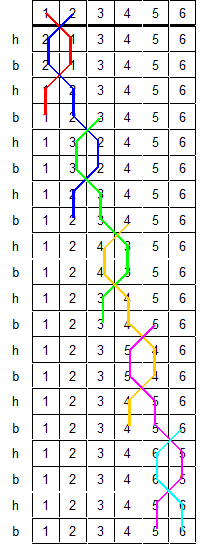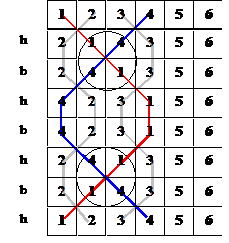Central Council Education Committee
 Learning Together - 4
Learning Together - 4
Making interesting places
by Peter Dale
This series is intended for inexperienced tower leaders and struggling bands of learners who’d love to make progress but are frustrated by the fact that they are all learning together. The first article observed that a tidy handling style contributes to good bell control, and stressed how important it is to aim for well-struck rounds. The second in the series explained how to move a bell one place “up” or one place “down”. This is something that ringers take for granted, but a learner will fluff it if they aren’t taught to do it properly.
Last time the frequency of moves between two places was increased until eventually a pair of bells were switching places every handstroke. This was referred to as “Place Making” and several variations were suggested to retain interest once the basic technique is mastered. This fourth article continues with the theme of taking small steps at a time by plagiarising from other authors two ideas for developing place making. They are both quite achievable by a novice band, and could be of some interest to a wider audience.
----------------------------------------------
 The first of these developments is known as “Mexican Wave”. It is buried deep within the bowels of the Central Council website1 but is gaining in popularity as more people stumble across it. It isn’t a “method”, but it gives the learner a glimpse into ropesight by cultivating a heightened awareness of their “place” in the sequence of changes.
The first of these developments is known as “Mexican Wave”. It is buried deep within the bowels of the Central Council website1 but is gaining in popularity as more people stumble across it. It isn’t a “method”, but it gives the learner a glimpse into ropesight by cultivating a heightened awareness of their “place” in the sequence of changes.
Teaching a Mexican Wave
- Place your more unsteady learners on non-neighbouring bells, e.g. 2, 4, 6, or 1, 3, 5, if the treble ringer can lead. Stand in the centre of the circle facing the ringers.
- Explain that they will be changing places with a neighbouring bell for one whole pull, starting at handstroke, and then returning to rounds.
- Point out that the bell following the changing pair will ring over a different bell for two blows, i.e. cover over a changing pair.
- Say, “Treble and two go next handstroke . . . and back into rounds”
- The next command is “Two and three go next handstroke . . . back into rounds”.
- Then do the same with 3 and 4, 4 and 5, and so on.
- Insist that the striking is accurate for each move, repeating if necessary, with several whole pulls of rounds between each command.
Fewer repetitions will be needed as the striking improves, so commands can then be given more frequently. Even when the changes are being made successfully every whole pull, the conductor may still have to prompt each move i.e. “Go Mexican Wave, 1 & 2 next handstroke . . . back into rounds, 2 & 3 next handstroke . . . back into rounds” etc.
The next step may be “Go Mexican Wave, 1 & 2. . . 2 & 3 . . . 3 & 4 . . .” and so on. When the band can cope with this reduced prompting the final stage is simply to call “Go Mexican Wave”. At this point you could use it for service ringing if required.
Why use it at all?
- It provides the first steps in learning to cover.
- It allows a learner to go on to and off the lead for just two blows at a time.
- It helps to develop accurate striking.
- More than one learner can ring at the same time.
- It makes learners more aware of their “place” and gives them the first glimmerings of ropesight.
- It’s an opportunity for calling at a very early stage; all the novice conductor has to say is “Go Mexican Wave” at a handstroke.
- It’s a stepping-stone between call changes and plain hunting.
- It’s fun and offers a little more variety than just call changes.
- It can be rung for service.
Variations on a Mexican Wave.
- Set another “Wave” going before the first one has got to the back.
- Start the “waves” from the back.
- Make each place twice: “Echo Mexican Wave”
- Start at backstroke.
- Start from Queens.
1Central Council web page: http://www.cccbr.org.uk/education/practicetoolkit/pdfs/fs_kaleidoscope.pdf
----------------------------------------------

This second development of Place Making has no name, but it doesn’t really matter what you call it, providing the band knows what you are you going to say and what you want them to do. You could call it “Whitefield Places” after its author if you wish.
Your novices should be quite proficient in basic place making by now and may have already been making two sets of places in parallel like this.
Now comes the tricky part. Look at the whole pulls where the ringers of 1 & 4 make 2nd’s and 3rd’s places respectively; one of them is circled. Consider what would happen if, every time these two bells come together, instead of making a place they change place.
The result is illustrated in the following diagram but as before take small intermediate steps in order to reach this stage. Let the place making settle down before making the first move, and then call the 1 and 4 to change. Make sure that the band knows beforehand what you will say, when you will say it, and what should happen as result. Continue ringing these parallel pairs of places, but now the 2 & 4 and 1 & 3 are place making partners.
This won’t come round of course, but you can either let it run for a while before calling stand, or be more adventurous and call 1 & 4 to change again. As the success rate improves, gradually increase the frequency of the calls until the 1 and 4 are hunting through 2nd’s and 3rd’s places every time.
The 2 and 3 still “do the same work” as they did in the parallel places, becoming reference bells in effect, providing a familiar framework in an unfamiliar situation. This has a good chance of success if each member of the band studies their rôle beforehand; brief them individually if you can. With so many learners you must place your band carefully.
In ascending order of difficulty:
 Place a rounds-only ringer on 6; for them this is just extended rounds practice.
Place a rounds-only ringer on 6; for them this is just extended rounds practice.- The ringer of 5 could also be a rounds-only ringer, but draw their attention to the regularity of the 3’s appearance in 4th’s place, and the fact that they must look out for 1 and 4 popping up alternately.
- Place a ringer on 3 who is very familiar with place making, but warn them to watch for the 1 and 4 crossing in front of them as they make 4th’s place.
- Arguably the ringer of 2 has a more demanding responsibility in that they must be able to lead accurately, while keeping a look-out to see whether it’s 1 or 4 that’s about to “take them off the lead”.
- One of your more promising learners should be placed on the treble. Although they will inevitably think of which bells they must follow, there’s clear scope here for encouraging the principles of rope sight.
- The ringer of 4 is the one most likely to cause disaster and, given half a chance, he or she will do so. Place your most experienced ringer on this bell, or ring it yourself. The uninitiated have no concept of how much they must check their bell to bring it down to lead in time. It is less disruptive to have the treble coming down too slowly at the end than to have the 4 messing it up right at the beginning.
Why use this exercise?
- It builds directly upon previous work.
- Learners at different levels can be accommodated at the same time.
- It provides the first steps in learning the mechanics of hunting.
- There is the opportunity to gain elementary ropesight.
- It can be rung for service.
A fairly obvious variation is for 1 and 4 to make the places, with 2 and 3 called to cross in the middle.
----------------------------------------------
A struggling band can succeed quite quickly with each of the exercises in these articles, without having to rely upon more experienced visitors. Sadly these weird and wonderful teaching ideas are not as widely used as we would like. In fact the situation may well arise when your learners may need to explain to a visiting ringer what to do, rather than the other way round.
When your band has mastered all the exercises described so far, and can strike them well, then you will have added sparkle to your Sunday repertoire. This may be as far as some of your ringers will want take their ringing, but for those who want to progress further there are more interesting challenges ahead. The next article will consider the dodging manoeuvre and how that raises the bar when it comes to bell control.
